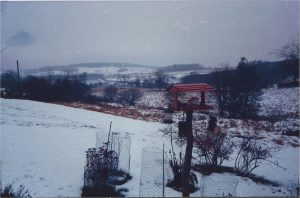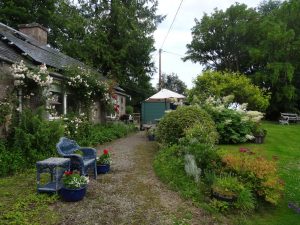
In memory of Gwendoline Edna Loader (nee Price), September 1910 – July 2007.
When my mother moved here in the early 1960s, the cottage was a newly renovated croft sited on a roadside amid a sea of rubble, a derelict landscape.
Once it had thatch, a tenant in the barn (now our bedroom), a cow in the byre (in my mother’s day the coal shed but now a utility room), and water was collected twice daily from a spring down at the burn. It must have been a tough life.
I know all this because soon after moving in in late 2012, I was working outside when a car halted on the road, drove on, backed, drove on again, backed again, and finally came to a halt.
A man emerged and, introducing himself as Peter Symon from Errol, shyly asked if he could take a photograph of Burnside, as it has been called for at least a century, if not – as old maps indicate – far longer.
Of course, I replied, but why?
It turned out that his aunt, Agnes Smith, had lived here until 1950. She used to make pancakes and large scones on the range, and relatives would set up a bell tent outside in summer for holidays. Also bee hives were transported to and fro.
It seems there were Smiths at Burnside for well over half a century…

Agnes in front of a very different-looking Burnside. In the 1901 census, it was described as a croft with – excluding the byre – four rooms and windows. A decade later, the census of 1911 counted three rooms and windows. Very odd. Today it has seven (some very small) rooms and eight windows. This archival photograph, from the personal collection of John (Jack) Joiner of Errol Village, Perthshire, was scanned and mailed to me in 2012, which in part explains the quality.
After Agnes died, the building stood empty on Forneth Estate until my uncle Charles Speid and his wife, my aunt Jo, decided to make it a home for her widowed sister, my mother Gwen. (So the two sisters, separated as youngsters by the death of their parents, could be reunited in middle age.)
But they only redesigned and fitted out the croft. The ground outside, rolling down towards the burn and with open views across the Lunan Valley, was for my mother to make her mark.

In the beginning… her view from the front door: Lunan Valley in the wild

Then came a bird table, some standard roses and shrubs, and to the right, the beginning of a rockery… Beyond, wild grasses wait in innocent bliss to be tamed for a lawn…

Early days for my mother, transplanted from city life into the most rural location imaginable, where she had to start anew in her mid-50s. I know she was lonely, felt isolated. But she never gave up.
And she did indeed make her mark over the years, planting first rambling roses around the door, and then in borders, choosing plants and shrubs that were equally as scratchy and painfully punative.

Winters must have been so hard. With only wire to protect her plantings from ravenous deer…
I could never work out why she made such choices? Was she trying to barricade and protect herself against the world, like the Sleeping Beauty of folklore, or was it a childlike mean streak? Knowing what I know now about her internal confusions, a bit of both I suspect.
She created a lawn, fenced against rabbits and deer, and called this her ‘garden’.
Down below the fence, the land was left to do its own thing…
To the side lies a triangle of land along the roadside that is still planted with ancient but once again magnificently fruiting redcurrant bushes. She tried to raise vegetables, but everything was against her: the wildlife, which ate just about everything, and the bogginess of the ground, flooding as it did back then on a regular basis.
At some point in the late 1980s, an enthusiastic neighbour came down and planted trees: rowans, elder, oaks, hazel and wild cherry. He insists to this day that he asked her and she agreed. She insisted to her dying day that he went ahead without agreement, that he “just did it”. Nowadays there is a limited view to the other side of the valley in winter, and none at all in summer.
Another huge change was the demise of the raspberry field.
Back in the 1960s and 70s, mother rented the tract of land across the burn (that had been gifted to her for her lifetime) to a local farmer. The area around here is famed for soft fruit, and he planted canes and cropped the fruit through the summer.

Shot from the top of the raspberry field, with staked canes and the hut down by the burn very much still in business. See the small evergreen to the right of the cottage? That was one of my mother’s Christmas trees. It is now higher than the oak tree seen behind, and still growing…
As he and my mother grew older together, to the point he could no longer work, the field returned to the wild, and is now a mature copse of mostly sycamore, nettles and willow herb.
My children remember running up and down the lines of canes in the 1970s, and in later years making a bonfire of the derelict hut on the burn side that had once stored equipment. Now my son harvests the copse, a tree at a time, to feed our log house and – once dried out – our wood burning stove.
By the time my mother died in 2007, ten years ago almost to the day, her ‘garden’ was a mound of weeds (plants in the wrong place at the wrong time), and her land reclaimed by nature. I had done my best every time I returned to see her from Japan, but really it was a losing battle.
Since moving here, we have worked hard and now the three parts of the ‘garden’ all are gaining and regaining their own identities. Nearer the cottage, the borders are slowly filling out, and the roses healthily under control.

She coped by coping… love the hat!
Along the fence that separates us from neighbours, a hedge is slowly becoming a wind break, alive with colour, texture and birdsong; how my mother coped with bitter winters and ferocious gales I cannot even begin to imagine!
Along internal fences, shrubs and flowering perennials mix with soft fruit – gooseberries, blackcurrants, goli berries, raspberries, blackberries… We have apple trees, hardy Scottish varieties. Even green tea bushes. And a lot of herbs.
Through 2014, we turned the boggy triangle into a labryrinth, for quiet reflective walks. The rest is planted with a crab apple, walnut, and most recently, a fig. In January it is a sea of snowdrops. Then come the daffodils. And in May, bluebells. (Currently, it’s nettle pulling time!)
This year, we have turned our attention to the field below the anti-rabbit fence. It’s a work in progress, obviously, and will be for some time. But already there are more fruit trees (Victoria plum, damson, nashi or Asian pear), mown paths (as there are around the labyrinth), a huge mown circle, with a bright pink ornamental cherry planted in the centre, and some rhododendrons finding their place around the edge…
We also have two benches. And a small pond.
This is located at the far end, towards the slate bridge over the burn, and where we erected a lintel from my aunt’s cottage, during its own renovation. (You can read about this in a blog from 2015: https://angelajeffs.co.uk/the-old-and-the-new/)
Alongside Akii planted a Yoshino cherry, to remind him of Japan, and several varieties of iris. Ironically he was in Japan this Spring when they all flowered.
The burn, running the length of the long side of an isosceles triangle? Almost invisible in mid-summer, overhung with ferns and brambles, with only the music of its coursing after rain to remind us that it’s there. It needs clearing again, but that’s a job for autumn into winter, so soon enough. (http://embrace-transition.com/2013/12/07/east-and-west-clearing-the-burn/)
Because the septic tank and lie of the land mean drainage, and intractable sedge grass, we decided to try and make a feature of its damp nature. Liam, who mows the lawn, slope and paths for us, offered us a small pond liner that he had “kicking around”, and dug it in for us at the backend of last year.
Now it looks thoroughly at home, overhung with ferns, with pond plants for aeration, a water lily, and more than a few baby frogs.
All very satisfying.
Now we are eyeing a far larger area, and thinking big. Liam is quite excited, it seems, and so are we.

The sycamore off centre to the right will be coming down in August, to open up this side of the burn even more.
The whole area of what we loosely term ‘the garden’ (about one and a third acres in total) is now green, healthy and blossoming. Even the copse is opening up, with a circle of cut log seating, a circle of stones for a bonfire, and deer as regular visitors.
It’s not easy to keep on top of, and I feel great frustration at not being able to work in it as I used to. How long we can hold on, I have no idea.
For the moment, however, it is pure joy to see its personality developing and broadening. Responding so positively to care and attention and love, it is full of birds, bees and even butterflies. (Initially there were very few.)
I choose to believe my mother is very pleased.

And yes, I have always loved red geraniums…

